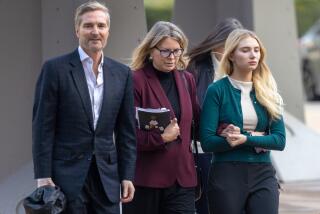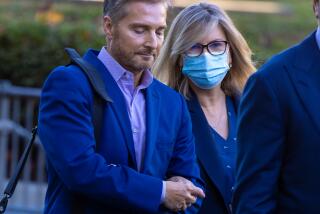Murder case against tennis umpire is dropped
From the beginning, the death of professional tennis umpire Lois Goodman’s husband was beset by contradictions.
When Alan Goodman, 80, was found dead in April at the couple’s Woodland Hills condominium, paramedics noticed a suspicious cut to the side of his head. But Los Angeles police initially agreed with Lois Goodman’s account that her ailing husband had fallen down a flight of stairs.
Days later, a coroner’s investigator found that the injuries were consistent with being struck by a sharp object. That ultimately led to Goodman’s dramatic arrest at a luxury Manhattan hotel as she prepared for the U.S. Open tennis tournament, with authorities claiming she bludgeoned her husband with a coffee mug.
PHOTOS: Murder case against tennis umpire is dropped
On Friday, prosecutors abruptly dropped a murder charge against her. Officials would say only that prosecutors received “additional information,” declining to elaborate.
But law enforcement sources told The Times that medical experts consulted by the Los Angeles County district attorney’s office concluded that the death could be the result of an accident, contradicting the coroner’s determination that it was a homicide.
The finding added to a long list of problems with the case, the sources said, that included a lack of a clear motive as well as other physical evidence that could help the defense. Moreover, genetic tests found none of Goodman’s DNA on the piece of the coffee mug that prosecutors had alleged she used to kill her husband.
After she left the courtroom Friday a free woman, Goodman, 70, insisted she was innocent and said she wanted to get back on the professional tennis tour, where she has been a fixture for decades.
“I feel wonderful,” she said, standing in the rain outside the Van Nuys courthouse, flanked by her attorneys. “I just feel I have been treated fairly now and it was just a tragic accident.”
The dismissal raised questions about how the case was investigated and whether both detectives and prosecutors rushed to charge Goodman. Last year, the LAPD acknowledged detectives had wrongly arrested a man in the high-profile beating of a San Francisco Giants baseball fan outside Dodger Stadium.
One of Goodman’s attorneys, Robert Sheahen, criticized the LAPD’s investigation, saying crime scene evidence undercut the theory that Alan Goodman’s death was a homicide.
A prominent medical expert, he said, told the defense team that Goodman was more likely to have died from heart failure, noting that his heart was four times the size of a normal heart. Blood evidence showed that an injured Goodman was downstairs at some point but was upstairs in bed by the time paramedics arrived, Sheahen said. Lois Goodman — who suffered from bad knees, a torn rotator cuff, rheumatoid arthritis and severe back pain — was in no physical condition to move her 160-pound husband, the attorney said.
“She would have needed a forklift to take the body up the stairs. It was ridiculous,” Sheahen said.
The LAPD declined to comment on details of the case, but LAPD Chief Charlie Beck released a brief statement.
“I am aware that the district attorney today declared that they are not ready to proceed in the Alan Goodman homicide trial and asked the court to dismiss the case without prejudice,” Beck said. “This is still considered an open case, and our Topanga-area homicide detectives will continue their investigation.”
Sources told The Times that prosecutors would review any new compelling evidence in the case and determine whether to refile charges but believed that would be unlikely. The sources, who spoke on the condition of anonymity because the case was ongoing, said there were obvious problems from the outset, noting that the coroner was never called to the crime scene. Some inside the district attorney’s office, they said, had questioned the public way in which Goodman was arrested. New York police took Goodman into custody after she had finished breakfast at a Midtown Sheraton and then walked her past photographers.
Steve Meister, a defense attorney and former Los Angeles County prosecutor, said district attorney’s officials deserve credit for dismissing the case when they realized they did not have enough evidence to proceed. Nevertheless, he said, the office should examine whether prosecutors could have anticipated the problems before they decided to file criminal charges.
“There needs to be a ... thoughtful, honest internal review process to figure out what went wrong here, because something clearly did,” Meister said.
From the outset, Lois Goodman told police she came home and found her husband dead in bed. She said she believed he crawled there after falling down the stairs and onto a coffee cup he was carrying.
At a court hearing earlier this year, a prosecutor accused her of plotting to kill her husband by wielding the broken coffee mug like an “improvised knife.” Shards from the mug were found embedded in his wounds. Prosecutors alleged that she left him to die and went off to “tennis and to get her nails done.”
A search warrant executed four days after the death turned up blood throughout the home “inconsistent with accidental death,” an LAPD detective wrote in the warrant affidavit. Stains on carpets, the refrigerator door, inside a linen closet and on the wall leading to the garage suggested “a mobile victim” who, police theorized, would have called for help.
They also found that Lois Goodman, married to her husband for nearly 50 years, was communicating on the Internet with another man, according to the warrant. One email described in the warrant included cryptic remarks about her “terminating a relationship” and having “alternative sleeping arrangements,” though exactly what she meant remains unclear.
But Lois Goodman’s supporters described her as a loving wife who cared for her aging husband. And her lawyers said she passed a lie-detector test administered by a former FBI examiner in which she denied killing her husband.
Hours after the court hearing, a bail bonds official cut off the electronic ankle bracelet that Lois Goodman was required to wear while she was out on bail.
“I didn’t do anything. I would never hurt my husband,” Goodman said, her eyes filling with tears. “I loved him and I was his caretaker, and he came first and I came second.”
More to Read
Start your day right
Sign up for Essential California for news, features and recommendations from the L.A. Times and beyond in your inbox six days a week.
You may occasionally receive promotional content from the Los Angeles Times.






